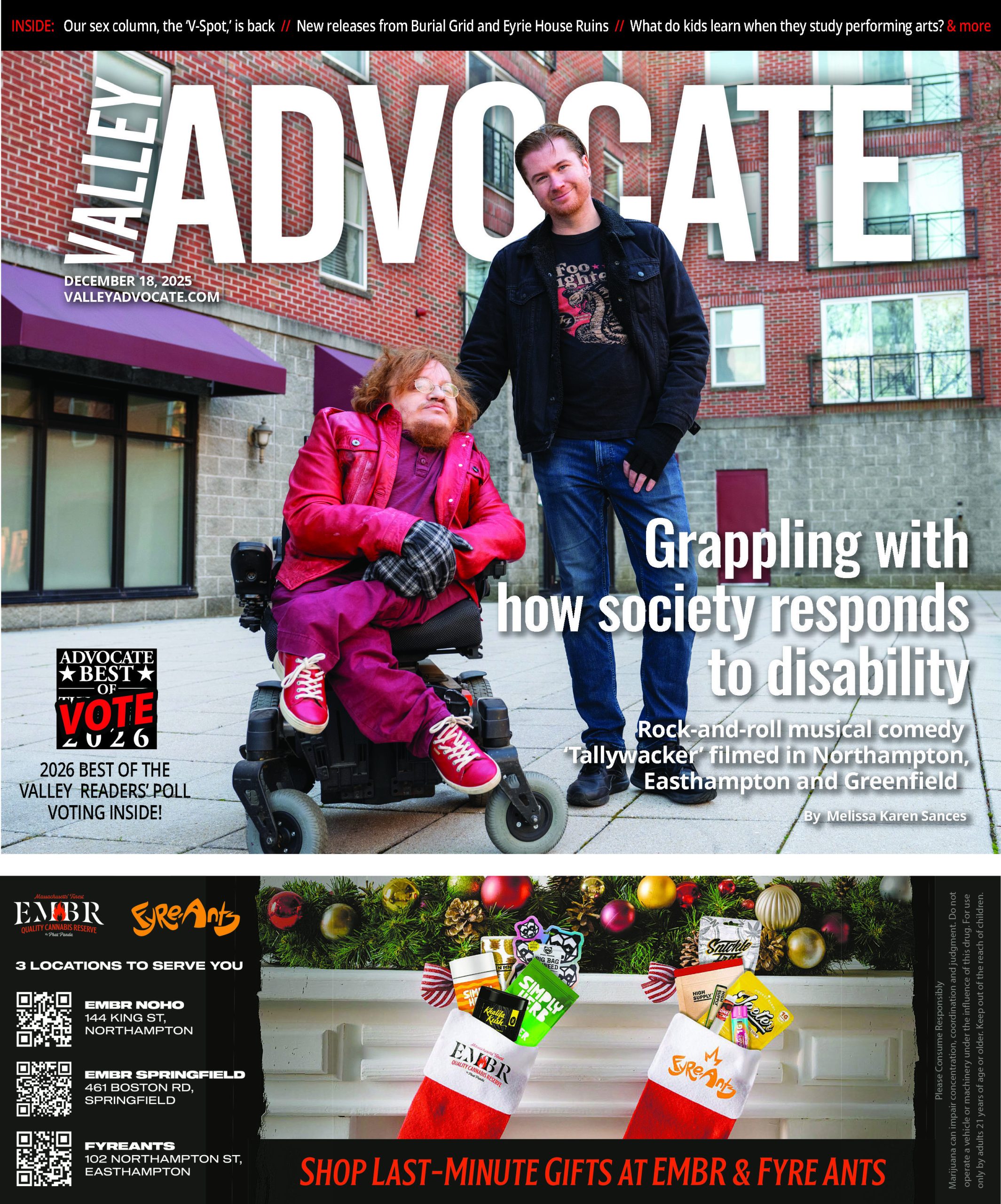The Body Follows: Inside the mind of professional contortionist Ariana Ferber-Carter
Many people would bend over backwards to avoid performing stunts in front of an audience. But Ariana Ferber-Carter — a professional contortionist and circus coach — is far more flexible, and her passion for the circus runs deep.
“What I do is intense and extreme, and I love it to death,” she says. “It hurts sometimes when I’m learning something new, but everyone’s body hurts sometimes. I’m planning on a nice long career.”
Ferber-Carter resolved to become a circus performer when she was six years old. At the age of 11, the Northampton native enrolled in classes at the New England Center for Circus Arts (NECCA) in Brattleboro. Her mother, a carpenter, built her a pair of wooden handstanding canes, and she spent her teenage years coming home from school to practice by herself.
Years of classes at NECCA led her to join Circus Smirkus, a nonprofit international youth circus, where she studied gymnastics, aerial arts, partner acrobatics, trampoline, and contortion during six summers on tour. Four years of work on cruise ships followed — a gig that took her on multiple trips through the Caribbean and Mediterranean.
Now 25 years old, Ferber-Carter recently moved to Leawood, Kansas, just outside of Kansas City, where she teaches classes at Lucia Aerial Arts and runs Pareidolia Contortion with her founding partner (and former cruise colleague) Liv Morrow.
But she will be back onstage in the Valley this week when she performs at NECCA’s seventh annual Circus Spectacular, a fundraiser for her alma mater’s scholarship program and new facility, slated to open in July. That show, held on March 4 and 5 at the Latchis Theater in Brattleboro, is a fresh chance to show audiences that contortion — a performance art based on feats of extreme flexibility — is an integral part of the history and traditions of acrobatics, dance, theater, and circus arts.
As a child, Ferber-Carter arrived at NECCA with some experience in tumbling and gymnastics, remembers Serenity Smith Forchion, the school’s co-artistic director. “She came to us knowing how to move,” she says. “She was always incredibly creative as a physical mover. I’m especially proud of her.”
Forchion began teaching circus arts in Brattleboro 2003 with her identical twin sister, Elsie Smith. Both sisters coach at the school, and both will perform in this year’s Circus Spectacular. Also performing alongside Ferber-Carter at the Latchis will be Troy Wunderle, the artistic director of Circus Smirkus.
Wunderle remembers the teenage Ferber-Carter as quiet and soft-spoken, but dedicated and full of grit. “Ariana is the perfect example of someone who followed a dream, and found people who supported that dream,” he says. “She’s come full circle, and it makes everyone who was a part of that circle feel proud.”
As an industry, the world of circus seems to be widening its big top every year. Last year, roughly 2,000 students came through NECCA’s doors, ranging in age from 18 months to 87. And these days, the job market can accommodate robust interest from professional-track circus students. As circus is increasingly seen as a fitness experience, teachers are needed not only at kids summer circus camps, but at trapeze classes sold to white-collar adults on their lunch breaks.
Performers are also in high demand at cabarets, comedy shows, burlesque clubs, corporate events, and on Hollywood stunt teams. The 2015 film Mad Max: Fury Road featured performers from Cirque du Soleil. Forchion, whose husband did acrobatic motion-capture CGI work for the animated film The Polar Express, has seen NECCA alumni perform circus arts in ballet, opera and touring musical acts. Artists like Britney Spears, Justin Bieber, and P!nk routinely share the stage with circus artists.
In other words: it’s real, hard work. And of course, contortion — which needs to be trained with abundant caution and attention, especially with young students — carries its own demands.
“Children don’t have as much ability to express verbally what feels okay and what doesn’t,” says Forchion. “It has to be taught with a lot of heart. Often we have to focus on strengthening, rather than stretching.” Across all body types, and each student’s individual abilities, “we have to stay curious about what the body can do naturally. In certain ways, we change the body, but we also must change the skills that the body is willing to do.”
Still, misconceptions abound. For some, the word “contortion” may conjure grotesque images of twisted figures turned strange through a series of snaps, crackles, and pops. It’s easy to picture hypermobility’s spooky side.
That take is outdated, and largely fictional. When Ferber-Carter mentions her profession in mixed company, it usually cues some amusing replies. “I get asked a lot if I put myself in a box,” she says.
True, that’s a traditional circus trick. But Ferber-Carter specializes in slower, more acrobatic contortion and balancing acts. “We’re trying to make this look beautiful, rather than freakish or weird,” she says. “At this point, when I look in the mirror while training, I’m asking myself: does this look smooth? How do I change this arm movement? Am I missing that beat in the music? Is the audience breathing with me? When are they clapping? Can I draw that out a little more?”
Range of motion comes easily to her, she adds, “so a lot of what I’m training is timing and control. I spend a lot of time wrangling my body.”
Contortion requires a combination of genetic disposition, control, focus, self-awareness, and work ethic. Contortionists focus on detail work — “being able to bend at one vertebra as opposed to the one next to it, for example,” she says. It takes serious muscle engagement and core support, honed over a lifetime.
In those early years at NECCA, Ferber-Carter’s future in contortion wasn’t immediately clear to her. “As a kid, you can’t really look at yourself and analyze that,” she says. “I knew I was flexible. But I wanted to do aerial arts, mostly. To a child, flying through the air looks more fun than staying on the ground.”
After a few years at NECCA, pre-teen Ferber-Carter realized that not many people were doing contortion. “I had an aptitude, and it was a smaller market. So I put my energy there. And when I started to figure it out, I was transfixed.”
It wasn’t an easy road — especially when puberty hit.
“Adults move differently,” she says, “and that means your stage presence has to change. As a kid, you’re all smiles onstage. But as an adult, you have to embody a character. How do you want your audiences to describe that character?”
It’s a question that young dancers also must deal with, she explains. “Teenagers have to find their voice in all sorts of ways — and when one of those ways is onstage, it can be very personal. Finding your self-expression is part of the journey you have to take while you train. It was difficult for me, but it’s cathartic now, to be on the other side.”
Ferber-Carter spends a lot of time stretching. Oversplits — splits in which the angle formed by a performer’s legs exceeds 180 degrees — are something that “I do every day, just like I brush my teeth.”
Same with pretzels, bridges, back beds, and a wide range of other moves.
These things come with time. In a back bend, she explains, “you have to breathe at the bottom of your breath, exhale all the way, then take a tiny slow breath, then exhale that, too. You can’t bend a full balloon, and you can’t bend a full ribcage.” Because of the pressure this creates in the torso, contortion training can be exhausting, and occasionally cause headaches. “We have to really pay attention to our bodies,” she says. “It’s a very methodical practice. If you skip a step, you’ll feel it later.”
Most recently, Ferber-Carter is proud to have achieved a consistent one-arm handstand that lets her feel balanced through her whole body. “I started nailing that about two months ago,” she says. “My hand is active, but I can feel exactly where my arms, legs, and chest are — really supported and stable. When your muscles are perfectly supporting you, it feels like being in the eye of a hurricane. You feel weightless, and in total control. That’s very different than tipping over into one spot and hoping that you stick there.”
Another move Ferber-Carter is training right now is the “elbow lever to handstand.” Place both palms down, hold your body horizontal a foot off the floor with a hip resting on one elbow, then curl your legs up and over so that your feet hang by your head. From there, press upward into a handstand position.
These are the types of feats that set contortionists apart from the simply flexible — what Ferber-Carter calls “controlling your body in a higher shape.”
And it all plays out in the classes she leads in Kansas City, where her students — aged 9 to 13 — learn to focus, work together, and commit to what is challenging.
“If you try a circus camp for one day, put some photos on Instagram, and go home, that experience burns off really quickly,” she says.
In a circus class, on the other hand, each day builds on the day before.
“They love to spin in the air, balance on the ground, and learn to trust each other,” says Ferber-Carter. “But if it wasn’t hard work, it wouldn’t be fun.”
Contact Hunter Styles at hstyles@valleyadvocate.com.


